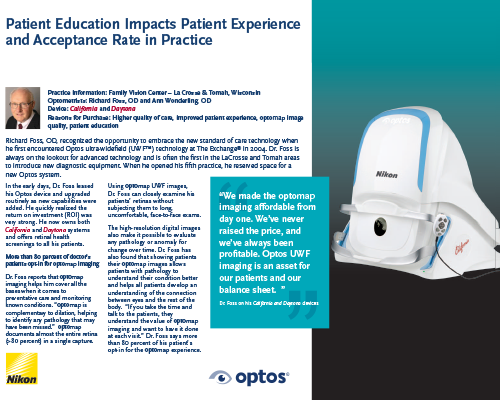Richard Foss, OD, of Family Vision Centers in both La Crosse and Tomah, Wisconsin boasts that optomap imaging helps him cover all the bases when it comes to preventative care and monitoring known conditions. He recognized the opportunity to embrace the new standard of care technology when he first encountered Optos ultra-widefield (UWF™) technology. Dr. Foss has both California and Daytona systems and offers retinal health screenings to all his patients.
“We made the optomap imaging affordable from day one. We’ve never raised the price, and we’ve always been profitable. Optos UWF imaging is an asset for our patients and our balance sheet.” Using optomap UWF images, Dr. Foss can closely examine his patients’ retinas without subjecting them to long, uncomfortable, face-to-face exams.
He is always on the lookout for advanced technology and is often the first in the LaCrosse and Tomah areas to introduce new diagnostic equipment. When he opened his fifth practice, he reserved space for a new Optos system.
Optos technology not only allows for connected relationships with the patients but with local Primary Care Physicians, as well. The optomap picture is truly worth a thousand words. The doctors are impressed with the technology and better appreciate when urgent treatment is needed.
In addition to color imaging, Dr. Foss also captures autofluorescence (AF) images on every patient. The value of this quick, additional image cannot be overstated. By examining AF images, Dr. Foss has identified several malignant tumors. These patients – children as well as adults – were asymptomatic when he made these life-saving discoveries.
“AF images highlight changes from one year to the next, and if something is out of whack, it allows us to more closely monitor the condition.” Dr. Foss explains that showing patients their optomap images allows patients with pathology to understand their condition better and helps all patients develop an understanding of the connection between their eyes and the rest of the body.
“If you take the time and talk to the patients, they understand the value of optomap imaging and want to have it done at each visit.” Dr. Foss says more than 80 percent of his patients opt-in for the optomap experience. “When people see what is happening in their eyes, it often encourages them to start taking better care of themselves.”
“Once they try it, they love it.” In fact, Dr. Foss says that when patients move out of the area, they often ask if he can refer them to a doctor who utilizes this technology in their new location. “I cannot imagine practicing without this technology. It is a winner with so many benefits! Before I had Optos, I was doing a good job, but once I got it, I realized how much better I could be.” Dr. Foss finishes by saying, “If you do not have this technology in your practice, you should schedule an in-office demonstration today.”
It's important to provide patients the technological advancements available with optomap. Retinal imaging fulfills a need in supporting the detection and management of both ocular and systemic disease and optomap provides the technology to make a clinical diagnosis and improve patient experiences. contact us today for your no-cost device demonstration.
